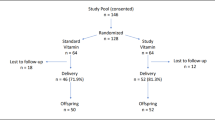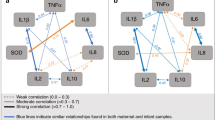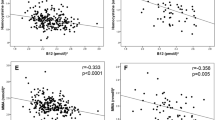Abstract
Objective:
Little is known about the effect of obesity on inflammatory status in pregnant women. The objective of this study was to determine the effect of obesity on markers of inflammation, oxidative stress and micronutrient status in obese pregnant women and their infants compared with lean controls (Lc).
Study Design:
This was a prospective case–control study. A total of 15 obese (Ob; body mass index (BMI) >30 kg m−2) and 15 lean (BMI 18–25 kg m−2) women were recruited based on prepregnancy BMI. Vitamins A, B6, C, E and 25-hydroxyvitamin D (25(OH)D), zinc, red blood cell (RBC) folate, C-reactive protein (CRP), interleukin-6 (IL-6), tumor necrosis factor-α and oxidized and reduced glutathione were measured from maternal blood between 24 and 28 weeks of gestation. Vitamins A, B6, C and E, 25(OH)D, zinc, red blood cell folate, CRP and IL-6 were measured from cord blood at delivery.
Result:
Ob pregnant women have statistically significantly lower levels of vitamin B6, vitamin C, vitamin E, RBC folate, higher CRP and IL-6 levels and higher ratio of oxidized to reduced glutathione compared with Lc pregnant women. Infants born to Ob mothers did not have statistically significantly higher measures of inflammation or oxidative stress. There were no differences in micronutrient concentrations between Lc and Ob infants, but folate, vitamin B6 and zinc levels correlated strongly between mother and infant. There was no statistically significant difference in any parameter between Ob and Lc cord blood.
Conclusion:
Ob pregnant women have increased inflammation and oxidative stress, and lower levels of nutritional antioxidant defenses compared with Lc pregnant women. We speculate that lower antioxidant defenses combined with increased oxidative stress and inflammation may contribute to the adverse outcomes associated with pregnancy in Ob women.
This is a preview of subscription content, access via your institution
Access options
Subscribe to this journal
Receive 12 print issues and online access
$259.00 per year
only $21.58 per issue
Buy this article
- Purchase on Springer Link
- Instant access to full article PDF
Prices may be subject to local taxes which are calculated during checkout




Similar content being viewed by others
References
Flegal KM, Carroll MD, Ogden CL, Curtin LR . Prevalence and trends in obesity among US adults, 1999-2008. JAMA 2010; 303 (3): 235–241.
Heslehurst N, Simpson H, Ells LJ, Rankin J, Wilkinson J, Lang R et al. The impact of maternal BMI status on pregnancy outcomes with immediate short-term obstetric resource implications: a meta-analysis. Obes Rev 2008; 9 (6): 635–683.
Ehrenberg HM, Mercer BM, Catalano PM . The influence of obesity and diabetes on the prevalence of macrosomia. Am J Obstet Gynecol 2004; 191 (3): 964–968.
Dennedy MC, Dunne F . The maternal and fetal impacts of obesity and gestational diabetes on pregnancy outcome. Best Pract Res Clin Endocrinol Metab 2010; 24 (4): 573–589.
Catalano PM, Farrell K, Thomas A, Huston-Presley L, Mencin P, de Mouzon SH et al. Perinatal risk factors for childhood obesity and metabolic dysregulation. Am J Clin Nutr 2009; 90 (5): 1303–1313.
Catalano PM, Ehrenberg HM . The short- and long-term implications of maternal obesity on the mother and her offspring. BJOG 2006; 113 (10): 1126–1133.
Koch L . Obesity: maternal weight linked to congenital anomalies in offspring. Nat Rev Endocrinol 2010; 6 (8): 418.
Rankin J, Tennant PW, Stothard KJ, Bythell M, Summerbell CD, Bell R . Maternal body mass index and congenital anomaly risk: a cohort study. Int J Obes (Lond) 2010; 34 (9): 1371–1380.
Oddy WH, De Klerk NH, Miller M, Payne J, Bower C . Association of maternal pre-pregnancy weight with birth defects: evidence from a case-control study in Western Australia. Aust N Z J Obstet Gynaecol 2009; 49 (1): 11–15.
Stothard KJ, Tennant PW, Bell R, Rankin J . Maternal overweight and obesity and the risk of congenital anomalies: a systematic review and meta-analysis. JAMA 2009; 301 (6): 636–650.
Shaw GM, Carmichael SL . Prepregnant obesity and risks of selected birth defects in offspring. Epidemiology 2008; 19 (4): 616–620.
Blomberg MI, Kallen B . Maternal obesity and morbid obesity: the risk for birth defects in the offspring. Birth Defects Res A Clin Mol Teratol 2010; 88 (1): 35–40.
Keaney JF Jr, Larson MG, Vasan RS, Wilson PW, Lipinska I, Corey D et al. Obesity and systemic oxidative stress: clinical correlates of oxidative stress in the Framingham Study. Arterioscler Thromb Vasc Biol 2003; 23 (3): 434–439.
Al-Aubaidy HA, Jelinek HF . Oxidative DNA damage and obesity in type 2 diabetes mellitus. Eur J Endocrinol 2011; 164 (6): 899–904.
Vincent HK, Taylor AG . Biomarkers and potential mechanisms of obesity-induced oxidant stress in humans. Int J Obes (Lond) 2006; 30 (3): 400–418.
Challis JR, Lockwood CJ, Myatt L, Norman JE, Strauss JF 3rd, Petraglia F . Inflammation and pregnancy. Reprod Sci 2009; 16 (2): 206–215.
Basu S, Haghiac M, Surace P, Challier JC, Guerre-Millo M, Singh K et al. Pregravid obesity associates with increased maternal endotoxemia and metabolic inflammation. Obesity (Silver Spring) 2011; 19 (3): 476–482.
Challier JC, Basu S, Bintein T, Minium J, Hotmire K, Catalano PM et al. Obesity in pregnancy stimulates macrophage accumulation and inflammation in the placenta. Placenta 2008; 29 (3): 274–281.
Radaelli T, Uvena-Celebrezze J, Minium J, Huston-Presley L, Catalano P, Hauguel-de Mouzon S . Maternal interleukin-6: marker of fetal growth and adiposity. J Soc Gynecol Investig 2006; 13 (1): 53–57.
Poston L, Igosheva N, Mistry HD, Seed PT, Shennan AH, Rana S et al. Role of oxidative stress and antioxidant supplementation in pregnancy disorders. Am J Clin Nutr 2011; 94 (6 Suppl): 1980S–1985S.
Mistry HD, Williams PJ . The importance of antioxidant micronutrients in pregnancy. Oxid Med Cell Longev 2011; 2011: 841749.
Agarwal A, Gupta S, Sikka S . The role of free radicals and antioxidants in reproduction. Curr Opin Obstet Gynecol 2006; 18 (3): 325–332.
Traber MG, Stevens JF . Vitamins C and E: beneficial effects from a mechanistic perspective. Free Radic Biol Med 2011; 51 (5): 1000–1013.
Reitman A, Friedrich I, Ben-Amotz A, Levy Y . Low plasma antioxidants and normal plasma B vitamins and homocysteine in patients with severe obesity. Isr Med Assoc J 2002; 4 (8): 590–593.
Kimmons JE, Blanck HM, Tohill BC, Zhang J, Khan LK . Associations between body mass index and the prevalence of low micronutrient levels among US adults. MedGenMed 2006; 8 (4): 59.
Han YS, Ha EH, Park HS, Kim YJ, Lee SS . Relationships between pregnancy outcomes, biochemical markers and pre-pregnancy body mass index. Int J Obes (Lond) 2011; 35 (4): 570–577.
Stern SJ, Matok I, Kapur B, Koren G . A comparison of folic acid pharmacokinetics in obese and nonobese women of childbearing age. Ther Drug Monit 2011; 33 (3): 336–340.
Gustafsson S, Lind L, Soderberg S, Zilmer M, Hulthe J, Ingelsson E . Oxidative stress and inflammatory markers in relation to circulating levels of adiponectin. Obesity (Silver Spring) 2013; 21 (7): 1467–1473.
Powell SR . The antioxidant properties of zinc. J Nutr 2000; 130 (5S Suppl): 1447S–1454SS.
James SJ, Cutler P, Melnyk S, Jernigan S, Janak L, Gaylor DW et al. Metabolic biomarkers of increased oxidative stress and impaired methylation capacity in children with autism. Am J Clin Nutr 2004; 80 (6): 1611–1617.
Sakakeeny L, Roubenoff R, Obin M, Fontes JD, Benjamin EJ, Bujanover Y et al. Plasma pyridoxal-5-phosphate is inversely associated with systemic markers of inflammation in a population of U.S. adults. J Nutr 2012; 142 (7): 1280–1285.
Behrens WA, Mdere R . A highly sensitive high-performance liquid chromatography method for the estimation of ascorbic and dehydroascorbic acid in tissues, biological fluids, and foods. Anal Biochem 1987; 165 (1): 102–107.
Bieri JG, Tolliver TJ, Catignani GL. . Simultaneous determination of alpha-tocopherol and retinol in plasma or red cells by high pressure liquid chromatography. Am J Clin Nutr 1979; 32 (10): 2143–2149.
Smith JC Jr, Butrimovitz GP, Purdy WC. . Direct Measurement of zinc in plasma by atomic absorption spectroscopy. Clin Chem 1979; 25 (8): 1487–1491.
Babson AL, Olson DR, Palmieri T, Ross AF, Becker DM, Mulqueen PJ. . The IMMULITE assay tube: a new approach to heterogeneous ligand assay. Clin Chem 1991; 37 (9): 1521–1522.
Camp VM, Chipponi J, Faraj BA . Radioenzymatic assay for direct measurement of plasma pyridoxal 5′-phosphate. Clin Chem 1983; 29 (4): 642–644.
Sen S, Simmons RA . Maternal antioxidant supplementation prevents adiposity in the offspring of Western diet-fed rats. Diabetes 2010; 59 (12): 3058–3065.
Farah N, Hogan AE, O'Connor N, Kennelly MM, O'Shea D, Turner MJ . Correlation between maternal inflammatory markers and fetomaternal adiposity. Cytokine 2012; 60 (1): 96–99.
Raijmakers MT, Peters WH, Steegers EA, Poston L . Amino thiols, detoxification and oxidative stress in pre-eclampsia and other disorders of pregnancy. Curr Pharm Des 2005; 11 (6): 711–734.
Hsieh TT, Chen SF, Lo LM, Li MJ, Yeh YL, Hung TH . The association between maternal oxidative stress at mid-gestation and subsequent pregnancy complications. Reprod Sci 2012; 19 (5): 505–512.
Berniakovich I, Trinei M, Stendardo M, Migliaccio E, Minucci S, Bernardi P et al. p66Shc-generated oxidative signal promotes fat accumulation. J Biol Chem 2008; 283 (49): 34283–34293.
Furukawa S, Fujita T, Shimabukuro M, Iwaki M, Yamada Y, Nakajima Y et al. Increased oxidative stress in obesity and its impact on metabolic syndrome. J Clin Invest 2004; 114 (12): 1752–1761.
Dao MC, Sen S, Iyer C, Klebenov D, Meydani SN . Obesity during pregnancy and fetal iron status: is Hepcidin the link? J Perinatol 2013; 33 (3): 177–181.
Shaw GM, Schaffer D, Velie EM, Morland K, Harris JA . Periconceptional vitamin use, dietary folate, and the occurrence of neural tube defects. Epidemiology 1995; 6 (3): 219–226.
Watkins ML, Rasmussen SA, Honein MA, Botto LD, Moore CA . Maternal obesity and risk for birth defects. Pediatrics 2003; 111 (5 Part 2): 1152–1158.
Conde-Agudelo A, Romer R, Kusanovic JP, Hassan SS. . Supplementation with vitamins C and E during pregnancy for the prevention of preeclampsia and other adverse maternal and perinatal outcomes: a systematic review and metaanalysis. Am J Obstet Gynecol 2011; 204 (6): 503.e1–503.12.
Vobecky JS, Vobecky J, Shapcott D, Blanchard R . Vitamin E and C levels in infants during the first year of life. Am J Clin Nutr 1976; 29 (7): 766–771.
Tsang R, Uauy R, Koletzko B, Zlotkin S (eds) Water Soluble Vitamins for Premature Infants 2nd edn. Digital Educational Publishing: Cincinnati, OH, 2005.
Laraia BA, Bodnar LM, Siega-Riz AM . Pregravid body mass index is negatively associated with diet quality during pregnancy. Public Health Nutr 2007; 10 (9): 920–926.
Rifas-Shiman SL, Rich-Edwards JW, Kleinman KP, Oken E, Gillman MW . Dietary quality during pregnancy varies by maternal characteristics in Project Viva: a US cohort. J Am Diet Assoc 2009; 109 (6): 1004–1011.
Rifas-Shiman SL, Rich-Edwards JW, Willett WC, Kleinman KP, Oken E, Gillman MW . Changes in dietary intake from the first to the second trimester of pregnancy. Paediatr Perinat Epidemiol 2006; 20 (1): 35–42.
Hanley MJ, Abernethy DR, Greenblatt DJ . Effect of obesity on the pharmacokinetics of drugs in humans. Clin Pharmacokinet 2010; 49 (2): 71–87.
Poston L, Raijmakers MT . Trophoblast oxidative stress, antioxidants and pregnancy outcome—a review. Placenta 2004; 25 (Suppl A): S72–S78.
Acknowledgements
This research was funded by the Tufts Medical Center Research Grant, The Natalie Zucker Research Grant and USDA contract no. 58-1950-7-707.
Author information
Authors and Affiliations
Corresponding author
Ethics declarations
Competing interests
The authors declare no conflict of interest.
Rights and permissions
About this article
Cite this article
Sen, S., Iyer, C. & Meydani, S. Obesity during pregnancy alters maternal oxidant balance and micronutrient status. J Perinatol 34, 105–111 (2014). https://doi.org/10.1038/jp.2013.153
Received:
Revised:
Accepted:
Published:
Issue Date:
DOI: https://doi.org/10.1038/jp.2013.153
Keywords
This article is cited by
-
Maternal and fetal/neonatal outcomes in pregnancy, delivery and postpartum following bariatric surgery and comparison with pregnant women with obesity: a study protocol for a prospective cohort
Reproductive Health (2024)
-
Supplementation with antioxidant micronutrients in pregnant women with obesity: a randomized controlled trial
International Journal of Obesity (2024)
-
Effects of posture changes on dynamic cerebral autoregulation during early pregnancy in women with obesity and/or sleep apnea
Clinical Autonomic Research (2023)
-
Maternal obesity and offspring cognition: the role of inflammation
Pediatric Research (2019)
-
Maternal folate status and obesity/insulin resistance in the offspring: a systematic review
International Journal of Obesity (2016)



